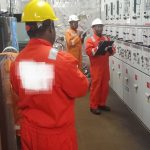 Offshore maintenance operations refer to the activities and procedures carried out to ensure the efficient and reliable functioning of facilities located in offshore environments, such as oil and gas platforms, wind farms, or other marine structures. These operations are crucial to sustaining the integrity, safety, and productivity of offshore installations. Here are key considerations for offshore maintenance operations:
Offshore maintenance operations refer to the activities and procedures carried out to ensure the efficient and reliable functioning of facilities located in offshore environments, such as oil and gas platforms, wind farms, or other marine structures. These operations are crucial to sustaining the integrity, safety, and productivity of offshore installations. Here are key considerations for offshore maintenance operations:
- Challenges of Offshore Environments: Offshore facilities are exposed to harsh environmental conditions, including saltwater, high winds, and corrosive elements. Maintenance operations must account for these challenges to prevent equipment deterioration and ensure the safety of personnel.
- Preventive Maintenance: Implementing a robust preventive maintenance program is essential in offshore operations. Regular inspections, equipment checks, and proactive repairs help identify and address issues before they escalate, minimizing downtime and extending the lifespan of equipment.
- Remote Monitoring and Diagnostics: Utilize advanced technologies, such as sensors and remote monitoring systems, to gather real-time data on the condition of equipment. This allows maintenance teams to detect anomalies, predict failures, and plan interventions without the need for frequent physical inspections.
- Scheduled Inspections: Conduct scheduled inspections of critical components, structures, and systems. This includes checking corrosion levels, inspecting pipelines, examining safety systems, and verifying the integrity of structural elements.
- Emergency Response Planning: Develop and regularly update emergency response plans to address unforeseen issues, such as equipment failures, leaks, or adverse weather events. Having well-defined procedures in place helps minimize the impact of emergencies and ensures the safety of personnel.
- Logistics and Transportation: Offshore maintenance requires careful logistical planning for transporting personnel, equipment, and supplies to and from the offshore installations. Coordination with marine logistics is crucial to ensure the timely arrival of resources.
- HSE (Health, Safety, and Environment) Compliance: Adhere to strict health, safety, and environmental regulations. Offshore maintenance operations must prioritize the well-being of personnel and the protection of the marine environment. Compliance with industry standards and regulations is paramount.
- Training and Competency: Ensure that maintenance personnel are adequately trained and possess the necessary competencies to perform tasks in the offshore environment safely. Training programs should cover the unique challenges associated with offshore operations.
- Corrosion Protection: Given the corrosive nature of saltwater, implementing effective corrosion protection measures is crucial. This includes applying protective coatings, cathodic protection systems, and regular inspections to identify and address corrosion issues promptly.
- Asset Management: Implement a comprehensive asset management strategy to optimize the performance and longevity of offshore facilities. This involves tracking the condition of assets, prioritizing maintenance based on criticality, and making informed decisions regarding repairs or replacements.
Offshore maintenance operations play a pivotal role in sustaining the reliability and safety of installations in challenging marine environments. Through proactive planning, advanced technologies, and adherence to industry best practices, organizations can ensure the continued operation of offshore facilities while minimizing risks and maximizing operational efficiency. Check out pictures of our recent offshore maintenace project









